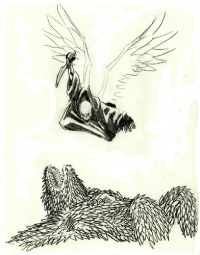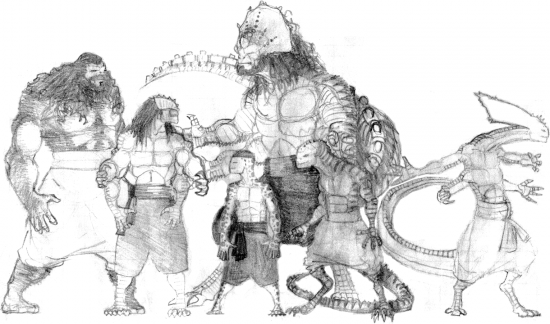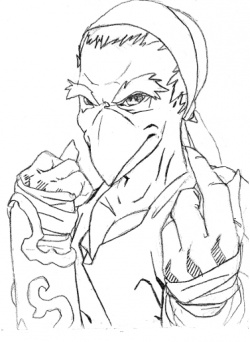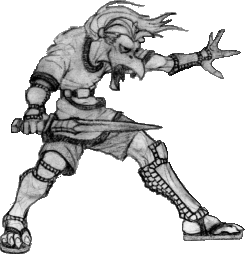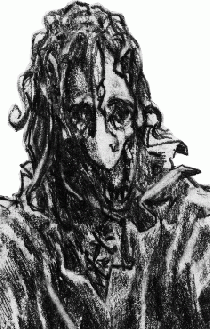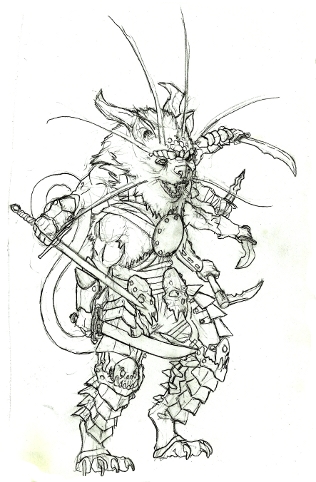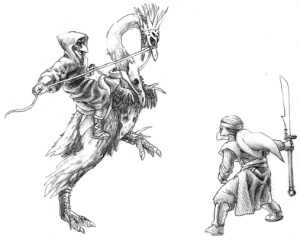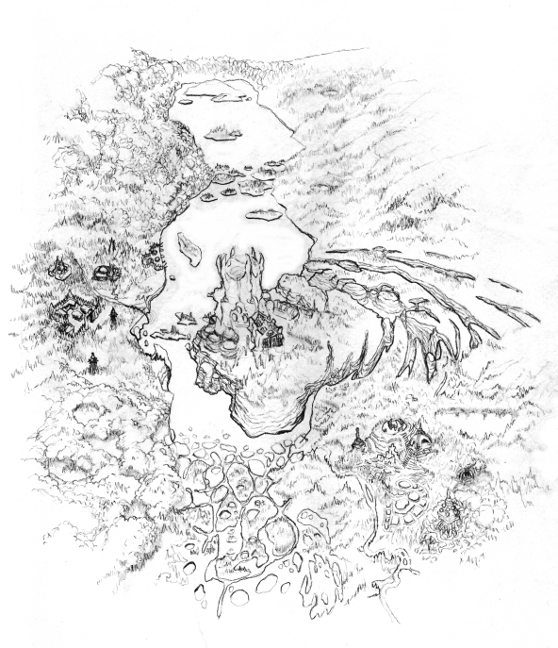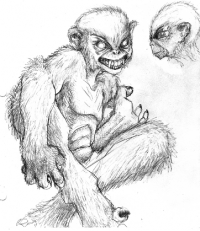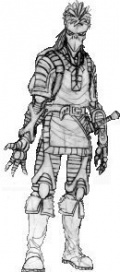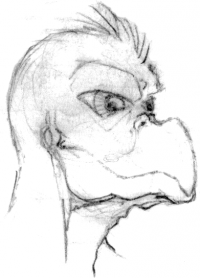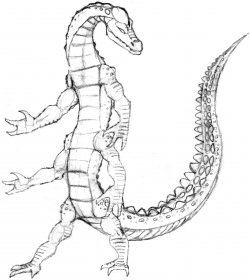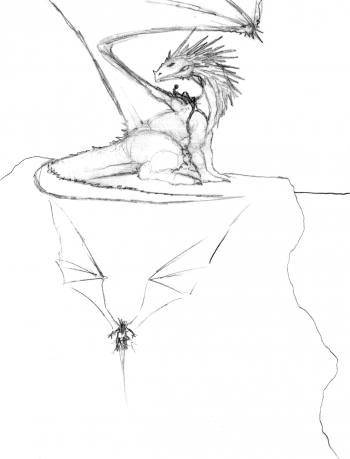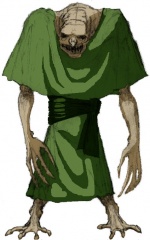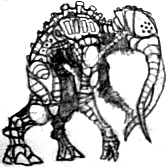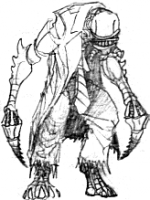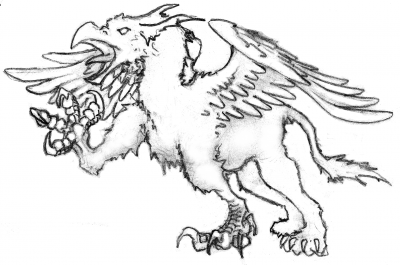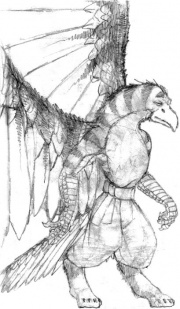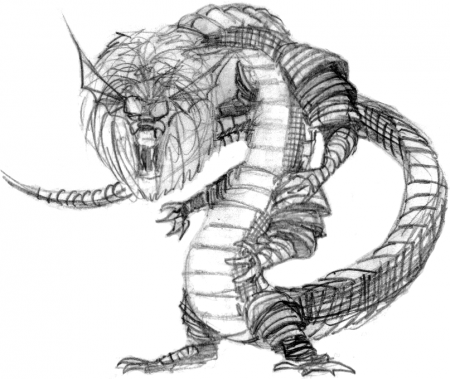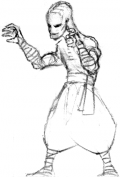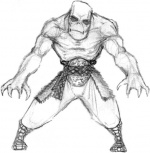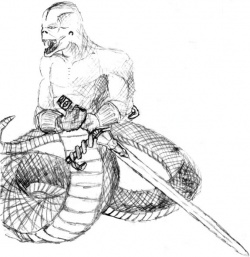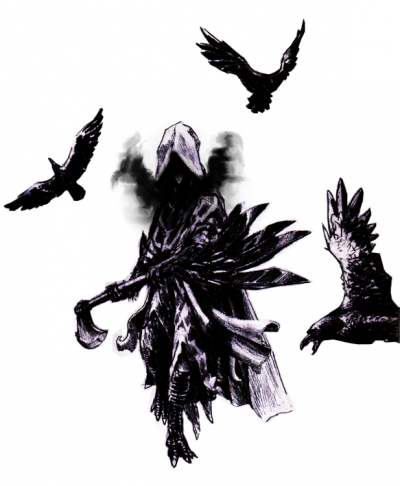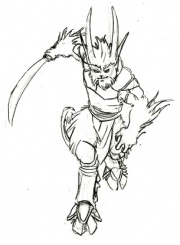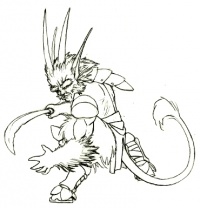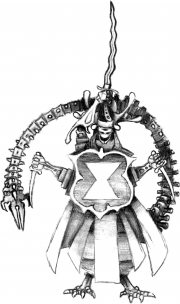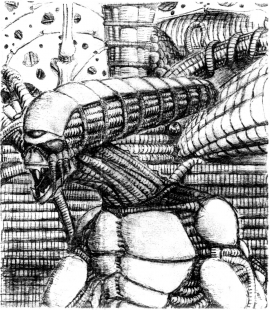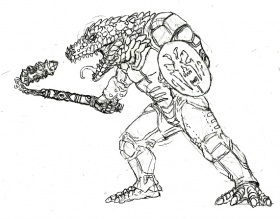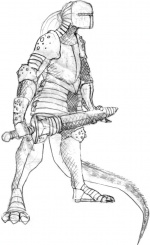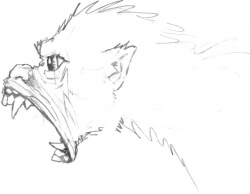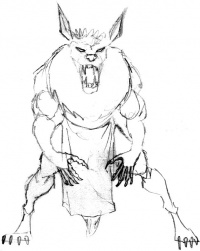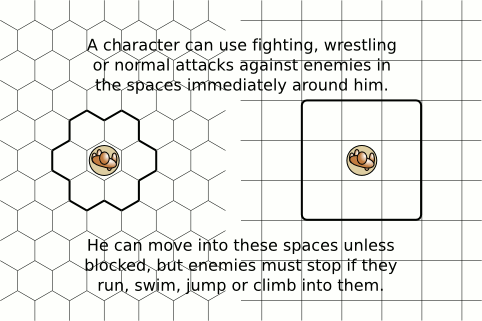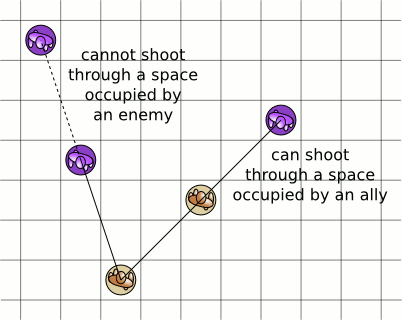Difference between revisions of "The Dark Woods"
BFGalbraith (talk | contribs) (→Dragon, Giant Flying) |
|||
| Line 426: | Line 426: | ||
== Scratch Role-Playing System == | == Scratch Role-Playing System == | ||
{{:Scratch:Complete System}} | {{:Scratch:Complete System}} | ||
| + | {{:Scratch:Agility,_Intelligence_and_Strength}} | ||
Revision as of 16:23, 14 April 2011
Contents
- 1 Introduction
- 2 History & License
- 3 Setting
- 4 Make PCs
- 5 Associations
- 6 Map
- 7 Encounters
- 8 Changing the Game
- 9 Scratch Role-Playing System
- 10 Basic Rules
- 11 Vehicles
- 12 Grid
- 13 Twenty-Sided Die Alternatives
- 14 Example Characters
- 15 Random Damage
- 16 Agility, Intelligence and Strength
Introduction
The Dark Woods is a Role-Playing Game where players take on the role of monsters and battle each other without a "game master." The players are divided into two teams of "sorcerers". (Sorcerers are intelligent monsters who become more powerful by defeating enemies.) The two teams take turns moving on the map, and play each others enemies as encountered on the map. The map itself explains what happens next in the plot of the game.
The Dark Woods uses the Scratch Role-Playing System for its combat and character creation rules. (A creative game master could use The Dark Woods as source material to run RPG adventures, but these rules do not specifically support that style of play.)
History & License
The Dark Woods as a project started around 1994 by the team of developers now known as the Game Arts Guild. (It was the project that spun off the Squawk Role-Playing Game. The original copyright is held by Benjamin Galbraith and Seth Galbraith of the Game Arts Guild.) The Dark Woods is now licensed under the Creative Commons Attribution Share-alike license. This license applies to art, rules, written content, other content, etc.
The Dark Woods is part of the Ancient and Deadly multiverse, but it is also a stand-alone player vs. player (GMless) Role-Playing Game.
Setting
The Dark Woods is a dangerous foreboding place full of monsters and violence. It appears to be an endless forest in a permanent state of twilight, and has many mysterious ancient ruins. The Dark Woods is a nexus that connects many other worlds together. (This entire collection of worlds and universes is called the "Ancient and Deadly" setting, or A&D for short.)
The Dark Woods is rife with mystical power called "essence." The higher up on the food chain a creature is, the more essence it accumulates. Intelligent creatures who intentionally use essence to become more powerful are called "Sorcerers." (Sorcerers from The Dark Woods are sometimes more specifically called "Cannibal Sorcerers" by outsiders.) Sorcerers come in many unique forms, and can even be in the shape of known types of monsters.
The Dark Woods is currently ruled by the powerful six-legged dragon sorcerer Kaizen. Most sorcerers either support the known ruler of The Dark Woods, or are involved in plots to overthrow that ruler.
Besides other groups of sorcerers, the biggest threat to sorcerers is the monster-hating Order of Thanatos and the beaked humanoid colos they have intentionally placed in The Dark Woods as an invasive species, in order to try to kill off the sorcerers:
"The Order of Thanatos has long recognized The Dark Woods to be a center of great evil amonst the many worlds that this place creeps into. The Order of Thanatos brought us colos here generations ago, because of our fast reproductive-cycles and pack-hunting instincts. The Dark Woods is deadly, but the our home world had been just as hostile in it's own Triassic way, until we colos overwhelmed that savagery using only bronze age weapons and technology. The Order of Thanatos converted some us to their cause, and those colos were sent to colonize The Dark Woods in an attempt to tame it as well. The part of The Dark Woods conquered by the decedents of those colos is now called "colo country" by those of us who dwell here. Know two things for certain. First venturing beyond the borders of Colo Country is a journey into the land of nightmares, and should only be done with careful military planning. Second, if you meet sorcerers, destroying those blights-on-reality is your duty, cause, and reason for existence; we are the angels sent to destroy these demons in their own hell!" - Ruben the Crusader Monk (from an academy lecture a few weeks before his disappearance.)
The Fall of the Blackmanes
An ancient, decrepit colo stood high in the air balanced on the top of a tall, ruined stone wall. Her black hooded witch's robe and her jet black hair flagged in the chilling, howling wind. Her eyes emitted a flickering shadow around her, the same way a torch would emit light in the darkness. She plucked thorns from her bleeding hands. The spiteful scowl on her face revealed her dismay.
Two heavily robed colos trudged down a dark misty wooded path. Monks of the Order of Thanatos traveled in groups of at least two. They were were prepared to investigate and if necessary exorcise a haunting on near the frontier of their territory. The older, in-charge veteran monk, Ruben, was a head shorter than his young, robust and inexperienced companion, Willard. Ruben had aged posture, but still had power in his stride. Willard appeared comfortably over weight, in spite of his height. They now rehearsed the details of their assignment.
“All you do is pound a stake into the heart of the corpse, which effectually paralyzes it, and then drag that corpse outside and burn it, which supposedly purifies it, right?” recalled Willard.
“Right, and stand back when you set it ablaze! These things can explode without warning. Last time I did this my companion was badly burned” shuddered Ruben.
“Why have they sent only two of us to take on such a dangerous foe?”
Ruben sized up Willard with a glance. He had chosen Willard because of his superior strength and size, but now he wondered if he should have selected someone with more appetite for swordplay. “I have dealt with several of these types before. This foe’s not dangerous, so long as you go when they sleep in the daytime, and of course, so long as you follow the procedure. What concerns me is the condition of the castle. It’s been decades since anyone has produced any details of the condition of the castle’s interior.”
“Oh, I see, you’re worried one of us might slip and fall, and the nearest village is a dozen miles off. Well, how did the Executioner come to haunt this place anyhow?” questioned Willard.
Ruben muttered, “Well, all that is really available amounts to little more than old wives tales.”
“Tell me what you’ve heard!” Willard not only wanted to know but felt a sincere need to know.
“Alright,” sighed Ruben, “before colo country was settled, the royal Blackmane family lived here."
"We're headed for the ancestral home of the Blackmanes?! They were one of the original tribes that immigrated from our homeworld! But wasn't Blackmane Manor destroyed in the later wars of purification?"
"Not destroyed, but abandoned, before those wars. The trouble started with a witch. An old hag stopped by one nasty evening, asking for a place to weather the storm. Well, they let her in. In fact, they invited her to eat with them. However, when the time to eat came she was nowhere to be found. Instead on her chamber floor lay foreign lettering, written out in fresh blood” stated Ruben as near by song birds of awoke and started to chirp.
“Fresh blood indeed! Drawn from where?” interrupted Willard.
“I’ll get to that part” continued Ruben, “when the guest disappeared, this became a topic of conversation at dinner. Soon everyone knew of the findings in her room. Arguing ensued as a strange rage took hold of all their hearts. The possibility of a curse was mentioned at the supper table and someone else said the notion was foolish. Then someone raised their voice at the notion that the notion of a curse was foolish, and then someone slapped them for yelling," explained Rub en.
"A punch was returned for a slap, a stab with a fork for a punch, and a drawn sword for a fork stab. Someone drew a sword to assist, and they were stabbed in the back by another. Two young brothers were wrestling in a death grip, just in front of the castle door, when they slipped and fell, still clinging to each other’s throats, and rolled down the castle stairs into the courtyard. Once off the castle steps they released each other almost immediately. They tried to help, but all inside were too infuriated to listen to their beckoning. Too busy killing each other you see. Fearing the violence, these two did not dare go back inside the castle until it was too late." Ruben stopped to wipe some water off his beak that fell from the leaf of an overhanging tree branch.
“Until it was too late? They went back in?” Thick fog was forming a slippery mud film on the trail.
“They found a sight of unspeakable carnage. The dead and their blood had been strewn all about the castle. But they found the executioner in the cellar kitchen. He wore his ceremonial hood and uniform, and was draining the blood from dead bodies into wine barrels. Apparently he was muttering a strange language to himself.”
“Old wives tales and their strange languages!” jested Willard.
“Well, they ran for it, escaping the executioner. That’s how the story goes, strange languages and all.”
“Ah, but what where did the hag get the newly drawn blood from to draw her archaic symbols with?”
“The brothers fled to near by authorities. After a few days of searching out and questioning possible suspects, an eccentric old beggar was found with bandages on her hands. The servants identified her as the witch. She claimed to not know how the wounds appeared on her hands and, as all wicked witches do, denied any involvement in witchcraft. For her lies, she was bound and burned alive." Ruben's voice had a dignified tone.
"At least the story has a happy ending” chuckled Willard in relief.
“Not quite, you see that was centuries ago. Ever since there have been sightings of this same Executioner, always at night, and always with his ceremonial burlap hood. No one dares approach the castle. Every year or two someone winds up missing in this region. There are hundreds reported missing now.”
The fog was clearing. The silhouette of the fortress roof startled Willard from his thoughts. “Look over there” exclaimed Willard nervously, “we had better get ready.”
At the side of the trail, they took off their robes, revealing backpacks, soft leather armor, brass breastplates and waist sheathed short swords underneath. Emptying their packs, they fastened iron helmets with face guards, mounted a large heavy mallet to each of their belts along with a few unlit torches, and strapped belts of barbed oak stakes on their shoulders. Willard hoisted a coil of rope onto his left shoulder, and Ruben stuffed the robes into the backpacks and hid the packs in the bushes. They continued quietly down the path.
The outer wall of the fortress, three or four stories high, was formed from small boulders and large rocks fitted together with crude mortar. If there had been a mote outside of the wall at one time, it had since eroded into obscurity, as vines and trees now grew up against the outside wall, preventing it's collapse in some places. The log supports used to build the wall were never removed from the inside, and had been used to maneuver atop the wall.
They quickly snuck through the large front gate to the courtyard, which lay broken and open. Creeping through the morning's wet, well-grazed grass to the courtyard, they quietly skirted towards the front entrance to the fortress. Willard gestured at a large, burnt wooden pole sticking up vertically in the middle of the courtyard.
Ruben replied with a shrug and pointed towards the castle’s front door. The castle it's self, a story or two higher than the outer wall in most places, was constructed in the same way as was the outer wall, but it was in poorer repair without the trees and vines to hold it together. From the ground it was impossible to tell if it had a flat roof or no roof at all, as there was some sort of old wooden frame work on top of the castle, but it's function was concealed by it's eroded condition, and by the fact it was covered by noisy, jet black, perched crows.
They carefully found their way to the creaking front steps, then through the main massive wooden double door, which already lay open for them enough to squeeze through without having to try to force the door open further.
The inside of the castle was unusually dark and dry. They stopped for a moment to light a single torch. Suddenly a floor plank gave out underneath Ruben with an audible “crack.” His arms lashed out to keep himself from falling all the way through, but he only broke more rotten wooden planks on his way to the darkness below.
"Are you OK?” screamed Willard, as he lay at the edge of the hole left by Ruben’s fall. Willard knelt down, lowering his torch to offer light into the large chamber below, which was full of old sturdy tables. Willard could see Ruben, who was picking himself up out of a pile of dust.
“I think I’ve found the coffin, hurry!” Ruben pointed to an object not clearly visible to Willard.
Willard squeezed his hands and felt liquid on them. He examined the edge of the new hole in the floor and noticed blood around its edge. However, it was not in random patches as he thought it should be. The blood seemed to form some sort of lettering. What does that word say.. is that a letter… not a letter, a number? No, some kind of symbol I think..." thought Willard, as he jumped back, dropping the rope into the hole, involuntarily screaming, “Ahh!”
“What is wrong Willard?” cried Ruben’s voice from the hole.
Willard shook his head in disbelief. The flickering lighting from the torch was poor; he must have been seeing things. “Nothing, I just slipped. I’ll be right down!”
“Hurry, get down here now! I'm in the kitchen, I'm sure!”
Willard carefully walked through the front hall into a dark cluttered room and then through another. Even with a torch it was difficult to tell much about what the castle's interior had been like before it had been abandoned. Besides the poor lighting, time had taken its toll on the Castle interior. He noticed there were definitely signs of a struggle, with turned over tables and discarded weapons lying about. The struggle had obviously ended long ago, as most everything was covered in dust and cobwebs. He noted that the presence of weapons meant that there had been few visitors since the struggle had taken place.
He found the staircase down and felt his way down using an old rickety handrail. Suddenly he heard an old lady’s voice, which with frozen breath whispered into his ear, “I’m going to rip out your lungs and soak my rose garden with your blood!”
“Ahh!” screamed Willard again, pulling his sword and swinging fiercely at the old witch behind him. However, all he hit was the rock wall of the staircase. A mangy old crow on the step behind him, where he thought the witch should have been, squawked loudly and flapped off into the shadows. He resumed creeping towards the cellar, shaking his head in unbelief and self-doubt.
Even before entering the kitchen, Willard noticed the large wooden coffin lying in the center of the floor. He crept through the cellar basement towards the kitchen, and then into it, cautiously creeping towards the coffin. "Don’t forget the procedure!" remembered Willard as pulled out a barbed oak stake with his left hand and readied his large wooden mallet. Willard paused as he noticed a large, bloody executioners axe lying against the coffin. Where is Ruben? he thought, oh no, the yelling! He must have awakened it! This thing has killed Ruben!
Willard grimaced as his fear turned to anger. He kicked the finely crafted wooden lid off of the coffin, revealing a hooded, bare-chested colo ghoul inside. He straddled the coffin, plunging the stake downward, following it with a massive swoop of his mallet. He struck the stake again a second time, but his third blow was stopped by the ghoul’s hand driving into his chest, throwing him off of the coffin and onto the cold floor, rear first.
As Willard rose to his feet, so did the creature, struggling to remove the stake from its body. “Oh no! I’ve missed the heart!” thought Willard when he saw that the stake protruded more from the throat of the ghoul than its chest. It waved at him with one hand threateningly as it pulled futilely at the barbed stake, causing a light spray of blood to darken its chest. Willard readied another stake and charged, thundering angrily “this one’s for Ruben!”
The creature side stepped out of the coffin off the line of Willard’s charge, grabbing Willard’s available mallet arm and swinging him into a cold stone wall head first, causing an audible “clang” from Willard’s helmet. The impact stunned Willard, and he dropped his stake and mallet as he stumbled to the floor.
Willard shook his head in pain, climbing to his feet. He could not believe the power of the creature he faced. He attempted to draw his sword, but was denied by a forceful boot to his mid section, which threw him back out of the kitchen into the darkness of the cellar. The ghoul chased after, half screeching, half gurgling.
Willard watched as the ghoul held the stake with one hand and lashed out in the dark with the other. He tried to quietly draw his sword. The ghoul turned and charged right at him, but this time Willard was faster; with a massive thrust he impaled the left side of the its lower body with his sword. For a moment it was stunned as Willard twisted the blade, causing vital fluids to spill out onto the floor. As the ghoul’s weight retreated, it slipped on some of its own drippings and stumbled. Willard let go of his sword and kicked at the creature’s legs will all of his might, sweeping it to the floor. He drew a stake and plunged downward with both hands.
Willard secured the stake with a series of stomps, but the ghoul kept writhing. He secured another stake, and then another. First binding the colo like feet with rope, he dragged the corpse by the rope towards the staircase. His sword scraped loudly as it was still impaled the creature, its point dragging on the cobble stone floor.
As Willard dragged the ghoul up the staircase, it finally quit writhing, its head sounding “thud, thud” with each step upwards. The sword made the dragging difficult as it snagged, making a clinging sound step after step. The body seemed to get lighter and lighter as he dragged. Someone stirred far off in the fortress, causing creeks and faint weeping sounds. Is that just crows, or is Ruben still alive? I’ll have to go find him after I finish this.
Willard dragged the ghoul through the dark cluttered rooms into the main front hall where Ruben had fallen through the floor. He stopped to catch his breath. He took off his helmet and breastplate to ease his burden. He debated whether to take the ghoul outside to burn it, or to risk burning it inside the dry interior of the fortress where it lay. Then he noticed the amount of damage done to the body, and how its loss of blood and other internal tissues had been the cause of it becoming lighter, forming a bloody, lumpy trail back into a cluttered room.
“Willard, thank goodness you’re safe” came Ruben’s voice from out of the shadows behind Willard. Ruben’s hunched, armored figure approached the downed ghoul. The creature spastically jolted to its hands and knees, desperately trying to get up. A massive sweep of Ruben’s boot sounded in the specter’s rib cage with an audible “crunch”, smashing the creature against a narrow pillar into a vulnerable prone position. Ivory tusks now protruded from the dripping, bloody, torn skin of the ghoul’s rib cage.
Willard walked to the front doors to put down his armor and to let more light into the structure. As he was pulling a door open he noticed that there was a large cluster of rose bushes very near the burnt pole in the courtyard. He scratched some dried blood off of his face, wondering why he hadn’t notice the roses before.
Then he noticed the burnt pole was no longer there. Willard panicked, pulling the door open with a series of forceful yanks, trying to protect himself with twilight from the confusing darkness of the fortress. Each yank produced an unsettling creaking, cracking sound as the door resisted Willard's force. When he finally got the door open wide enough, he glanced back inside. They had created more of a mess than he thought, with blood splattered about from the corpse. “Take off its hood, let's get a good look at it” insisted Willard desperately.
The hunched figure hefted the corpse by the throat into the air with one hand, yanked the hood off with the other, and chucked the body across the room into Willard, knocking him to the floor. Ruben’s face gazed up at Willard from the mutilated body. “Nooooooo !” cried out Willard as he realized his mistake. Willard knew he had tortured and killed his own mentor. "Back in the cellar someone must have dressed Ruben up to look like the ghoul!" he realized suddenly.
The ghoulish figure removed Ruben’s helmet it had been disguising itself with. Willard could make little distinction between the darkness of the shadows and the shadowy evil of the head of the creature, because of a dark fog around it's head. He was bare able to make out the beak of a colo.
The creature glared over at Willard, stake in hand. “Now we will see how you like it…” screeched a familiar, yet twisted voice of an old lady. Leaping to his feet, Willard pulled a stake and charged. The burlap hooded ghoul intercepted Willard’s lunge, impaling Willard’s chest with a barbed oak stake. Sudden darkness ended all of Willard’s pain and confusion.
An ancient, decrepit colo stood high in the air balanced on the top of a tall, ruined stone wall. Her black hooded witch's robe and jet black hair flagged in the chilling, howling wind. Her eyes emitted a flickering shadow around her, the same way a torch would emit light in the darkness. She plucked thorns from her bleeding hands. The spiteful grin on her face revealed her wicked glee.
Make PCs
Every player has one personally designed character called a "PC" (or "player character.") This PC feeds on the essence of his fallen foes to become more powerful, technically making it a sorcerer. The antagonist in "The Fall of the Blackmanes" (who is known as The Old Crow in this game,) is one example of a very experienced sorcerer in The Dark Woods. However, these kind of sorcerers can take almost any form. A sorcerer could be a mighty warrior, a dragon, some other dangerous monster, or even something more subtle. Players should use their imagination, and use the Scratch Role-Playing System (see Basic Rules) to make a sorcerer with a maximum ability level of 5 and a maximum total ability level of 13.
Here are some questions to answer when making a good character description of a sorcerer: How does your PC feed on the essence of a fallen foe? (Does your PC use fangs to "suck their blood," make a soup out of them in a large black cauldron, use a talisman to absorb their aura, or some other sinister technique?) What is it about your PC that makes it have the abilities it does? What is the origin of your PC? What shape does your PC have now? How does your PC defend itself? What is your PC's personality like? What equipment does your PC use on a regular basis?
Associations
The players are divided into two gangs of sorcerers, "team 1" and "team 2." These two groups are in a race to see who can defeat Kaizen first, and thus become the new rulers of The Dark Woods.
Each team's group of PCs should have an association with a part of the larger social structure in The Dark Woods. Each association has certain effects on the team. Each team can only have one association, and the two teams must have different associations.
Colonists
Your PCs can pass as not-warped-beyond-usual by the essence of The Dark Woods, and the Order of Thanatos does not suspect you of sorcery. The colos are impressed by your apparent piety and mastery of Judeo-Christian or Order of Thanatos scripture, and authorize you to explore and colonize The Dark Woods.
Whenever your PCs encounter Colo Crusaders, you can choose to not fight them (and also then not get to feed on their essence.) You can also fight them as normal.
Necromancers
At least one of your PCs is completely obsessed with mastering the darkest arts, willing to take on any rival power to demonstrate his/her/it's supremacy. The other PCs either share his interests or accommodate him out of fear of what he might do if angered.
Whenever your PCs encounter Hungry Ghouls, you can choose to fight the Hungry Ghouls as normal, or instead have the Hungry Ghouls immediately attack the other team.
Raiders
Your PCs are a well organized group of experienced plunderers. You are here to take The Dark Woods for all it's worth.
Whenever you successfully defeat Boggarts, you each get one additional ability point because you are able to shake them down for their local stash of magic items and treasure, before you feed on their essence.
Rangers
Your PCs have studied philosophy and martial arts with the dryads. You have entered a pact with them to rule The Dark Woods with the utmost care for environmentalism and biodiversity.
Whenever your PCs encounter Dryad Druids, instead of fighting them your encounter is automatically successful, as your PCs take this opportunity to practice zen "rooting" meditation, knock-down "branch-sparring," "tangle vine" Tai Chi and other ancient training techniques that help your PCs focus their essence more efficiently.
Scholars
At least one of your PCs has a background in helping Seekers collect specimens.
Whenever your party encounters Seeker Abductors, your party can choose to be transported to any space other than Kaizen's Lair, where you will begin your next turn. However, you may not fight the Seeker Abductors or feed on their essence.
Map
Each time this game is played, and after the PCs have been divided into two teams, one player should roll a 20 sided dice to see if all the PCs on his team will be team 1 or team 2. If he rolls above a 10, then his team is team 1, and otherwise his team is team 2. The same player should then roll a 20 sided dice again. If he rolls above a 10, then his team goes first. Otherwise, the other team goes first.
A team can each move one space on their turn. The new space will have instructions on how to determine what happens when the team moves to that place. Do not repeat these instructions unless your party moves off that space and then back onto it. Kaizen's Lair in the middle of the map can only be moved to from the Eastern Crags space.
| Silent Groves:
Team 1 Start Random Encounter |
Lake of the Lost:
1-9: Crocodiles 10-16: Crocodragons 17-20: Random Encounter |
Howling Hills:
1-12: Wargs 13-20: Random Encounter |
| Colo Country:
1-2: The Old Crow 3-14: Colo Crusaders attack from fort. 15-20: Nothing; colos hunted all enemies to extinction in this area. |
Kaizen's Lair:
Fight Kaizen and his crocodragon followers. |
Savage Gorge:
Entrance to Kaizen's Lair 1-7: Each PC must make a flying, acrobatics, or swimming check vs. 12, or team skips next turn. 8-15: Dragon, Giant 16-20: Random Encounter |
| Grim Glades:
Team 2 Start Random Encounter |
Forbidden Bog:
1-9: Nagas 10-20: Random Encounter |
Ancient Ruins:
1-2: The Old Crow 3-12: Varana attack your party to protect their territory. 13-20: Random Encounter |
Encounters
When a team takes on enemies, there is always an equal number of enemies to team members. The opposing team's players controls the enemies to see what kind of damage they can do to this team.
If a team defeats all of their enemies in an encounter, then that encounter is successful, and each character on that team gets one ability level to add to any ability they choose. This is because they are able to feed on the essence from their fallen foes, dramatically enhancing their power.
If the team is not successful, but at least one of the team members successfully flee, then their encounter is not successful, but they continue the game as normal on their next turn.
If the team is not successful, and none of the team members escape, then the team moves back to the space they started on their first turn, which is where they begin on their next turn.
Random Encounters
If "random encounter" is called for, roll a 20 sided dice to see which of the following encounters happens (never do the same encounter twice in a row for each team - if the team did the roll encounter the as their last combat-encounter, then roll again):
1: The Old Crow
2-4: Colos
5-6: Satyrs
7-9: Gryphons
9-10: Boggarts
11-12: Dryads
13-14: Ghouls
15-16: Morlocks
17-18: Seekers
19-20: Wargs
Team vs. Team
If the two teams ever go on the same space, and either team wishes to fight, then the teams will directly engage each other in combat. All of normal rules apply to this combat as with other encounters.
If one team is smaller than the other, than the larger team must choose which of it's PCs will fight the smaller team, and they should choose the same number of PCs that the smaller team has.
List of Encounters
Boggarts
Boggarts are malevolent ferry folk with a taste for the property and discomfort of others, using fearsome trickery to exact their twisted will. They appear as dwarf humanoids, covered in monkey like fur and who's grin reveal vampire like fangs.
Boggart Robbers (7 stalking, 4 wrestling, 2 toughness, 1 tgh/2, 17 defense) jump the PCs in an attempt to steal their equipment.
Colos
The most common intelligent creature in The Dark Woods is the colo. Colos come from a world like Earth's Triassic period. There they thrived as their homeworld's foremost predator, having a strong pack hunting instinct. These bird-like humanoids reproduce faster than humans, but have a naturally shorter life span than humans. Colo cultures tend to be focused on heroic accomplishments, often in the form of collecting impressive hunting trophies.
Colos were intentionally introduced to The Dark Woods by the Order of Thanatos. This ancient order wished to end the practice of sorcery in The Dark Woods. The colos they brought were indoctrinated and trained by the order, so that most of the Colos claim the Order of Thanatos as their religion.
Most of colo society in The Dark Woods is focused on a crusade to hunt and destroy all the sorcerers in The Dark Woods. These colos live in forts filled with many large families. The social structure is miltaristic, with each fort being led by a "captain" and his many "officers." (Many a sorcerer have commented that colos "taste like chicken," but many more have found themselves overwhelmed and executed by colos.)
Heavily armored and well trained Colo Crusaders (1 stalking, 2 fighting, 2 shooting, 5 toughness, 2 tgh/2, 12 defense) on a routine patrol notice the PCs, and attack in righteous fury they assume your PCs are involved in sorcery.
Crocodiles, Large
Large crocodiles (3 wrestling, 2 swimming, 3 stalking, 6 toughness, 3 tgh/2, 13 defense) are armored archosaurs that live mainly in water. If the big reptiles can drag a character back into the water they will hold the character under until he drowns.
Crocodragon
Crocodragon are swamp-dwellers. Although longer than a crocodile, the crocodragon is considered a relatively small dragon.
A Hungry Crocodragon (5 swimming, 4 wrestling, 3 stalking, 1 knockout, 5 toughness, 2 tgh/2, 13 defense) has been stalking the PCs and attacks.
Dragon, Giant Flying
Thaumaturgists from Gaia and people from other worlds have discovered species of large flying dragons that can be used as aerial vehicles and flying weapons platforms. These dragons on average are much larger than elephants, and have large wingspans compared to most other flying creatures.
A Conquering Giant Flying Dragon (4 knockout, 2 wrestling, 3 flying, 14 toughness, 7 tgh/2, 13 defense) is violently alarmed that the PCs may be rivals in his political arena. This Dragon is accompanied by Human Explorers (1 shooting, 2 healing, 2 acrobatics, 3 toughness, 1 tgh/2, 12 defense) armed with light firearms and combat-veterinary training.
Dryads
Walking, talking plant-hybrid humanoids have been found in The Dark Woods called Dryads. The Dryads are covered in protective bark, have long noses, have two arms and long torsos, and walk on two legs. The Dryads are fast healers, and consider themselves to be guardians of The Dark Woods. The Dryad culture is the only culture void of taboos against sorcery in The Dark Woods. Dryad sorcerers have been known to take the form of hulking trolls or walking tentacled trees.
Dryad Druids (3 stalking, 3 wrestling, 1 knockout, 6 toughness, 3 tgh/2, 14 defense) ambush the PCs after overhearing the PCs environmentally unsound plans for The Dark Woods once they have taken the reigns from Kaizen.
Ghouls
Ghouls are undead who develop grotesque mutations. They can absorb the aggressive and defensive characteristics of whatever they eat. Unlike the Sorcerers of The Dark Woods, ghouls can absorb abilities and features from creatures that have no magical essence. (See Sorcerer.) It is thought that the Ghouls are from the outbreak that destroyed the home world of the Order of Thanatos, and that the order believes that somehow the Ghouls and the essence of The Dark Woods are related. Creatures killed by ghouls often rise as ghouls themselves if they have not been eaten.
Hungry Ghouls (1 wrestling, 2 fighting, 4 toughness, 2 tgh/2) from a fallen world have wandered into this one in search of flesh, and attack the PCs in ravenous desperation.
Gryphons
Gryphons combine the wings, head and talons of an gigantic eagle combined with the body and four legs of a lion.
Gryphons of The Dark Woods are often colo sorcerors who have acquired attributes of big cats and predatory birds on their way toward becoming dragons. This type of gryphon sometimes have unusual features like stripes, spots, leathery bat wings or feathered tails.
Guardian Gryphons (3 flying, 4 fighting, 6 toughness, 3 tgh/2, 13 defense) attack when the PCs get too close to an ancient tomb they are protecting.
Kaizen
Dragons come in many shapes and sizes. In The Dark Woods, many dragons are sorcerers who have twisted their bodies into the form of a dragon to maximize their power. Kaizen was born a strider, and evolved himself into his current six-legged dragon form through practicing sorcery for many years.
Kaizen (6 stealth, 4 wrestling, 3 shooting, 2 knockout, 9 toughness, 4 tgh/2, 16 defense) is accompanied by crocodragon followers. He is large, armored, fast, extremely clever, and has a fiery breath weapon. He feeds on essence by inhaling the smoke from his victims burning corpses.
Morlocks
Morlocks are subterranean humanoids with large dark eyes and pale, yellowish or gray skin. They are mostly or entirely bald and have tiny ears and flat noses. Morlocks evolved from humans before discovering the Dark Woods, while exploring time and space. Morlocks are excellent climbers. Sorcerers that were once Morlocks often have telekinetic powers that allow them to levitate things, climb on ceilings or leap unnaturally high.
Morlock settlements are always found underground, and are often organized into industrial communes called "unions." Some settlements have been discovered that have been ruled by sorcerers, generally referred to as "Morlock Cults."
Concerned that your PCs might be speculating on the value of their property, Morlock Underminers (3 acrobatics, 2 fighting, 2 wrestling, 3 toughness, 1 tgh/2, 13 defense) attack using acrobatic rope techniques and pick-axes.
Nagas
Nagas are serpentine creatures with a humanoid head, arms and upper body attached to the lower body and tail of a very large snake. They specialize in paralyzing their opponents with venom. Nagas are descendants of human treasure hunters who settled in The Dark Woods, who over generations have been warped by the essence. Nagas scavenge The Dark Woods seeking treasure to horde, and get violently territorial about ruins they think hold valuable secrets.
The PCs are ambushed by naga bandits (3 knockout, 2 stalking, 1 fighting, 3 toughness, 1 tgh/2, 12 defense) interested in any artifacts the PCs may have found in their travels.
The Old Crow
The Old Crow is a former female colo zealot of the Order of Thanatos. She was one of the original Blackmanes. (The Blackmanes were one of the tribes converted to the Order of Thanatos back on the colo home world.) She was an accomplished hunter and researcher. Her research led her to dabble in sorcery, which eventually consumed all of her research activities, and then eventually turned her into a sorcerer herself. Hundreds of years later, she is the most feared sorcerer amongst the colos in The Dark Woods, as she dares to incur on their territory and feed directly on their population.
The Old Crow (6 stalking, 2 acrobatics, 2 knock out, 5 wrestling, 7 toughness, 3 tgh/2, 16 defense) is supernaturally fast and strong. She is an expert illusionist, terrifying and intimidating her enemies. She wears a large dark cloak and robes, and emits a mysterious dark fog around her person, making it more difficult to attack her. She has evolved to have distinctly crow-like features, with her fore arms having large black feathers giving them a wing-like appearance. These psuedo-wings help her manipulate the dark fog that surrounds her. She conceals an executioner's axe as her primary self-defense weapon. She is accompanied by Attack-Crow Swarms (1 blasting, 4 flying, 4 toughness, 2 tgh/2, 14 defense.)
If the Old Crow is defeated, she explodes into black smoke and disappears. Unlike Kaizen, she can't be permanently defeated by the PCs. (If she were to become the ruler of The Dark Woods, she would take a more material, mortal form in order to maintain her position. She does not seem to be hunting Kaizen yet, focusing primarily on other sorcerers and colos.) The Old Crow absorbs the essense of her fallen prey by draining the victim's blood into rose bushes, and then eating the roses. Her roses can move very quickly from place to place, emerging from the ground just as she is preparing to feed. If the PCs can defeat her, they can feed on her roses which will in turn give them essence.
Satyrs
Satyrs come from a world where mammal life evolved differently from Earth's.
Satyr Bounty Hunters (3 fighting, 4 quickness, 4 toughness, 2 tgh/2, 14 defense) confront you because an old enemy has placed a price on your head.
Seekers
The seekers come from a swampy world of giant insects with an atmosphere stiflingly rich in oxygen. Seekers walk on two legs, have wickedly sharp tails, are mostly covered in exoskeletal armor, and have elongated heads, 3 eyes and four arms. Seeker technology avoids volatile chemistry and fire, and specializes in medicine, biochemistry, and preserving knowledge.
Seekers hatch from egg clutches numbering in the hundreds, and seekers are under pressure to make a name for themselves as individuals. Seeker culture is highly intellectual, and Seekers are constantly exploring to find new knowledge to bring home to their hive. Seekers are constantly taking samples and notes, making observations from afar, and conducting impromptu interviews when appropriate for their studies. Sorcerers tendency towards developing unique anatomy is of particular interest to seeker abductors. Seekers have been known to take temporary captives simply to observe their behavior, to murder and preserve intelligent specimens with no warning, or to join causes simply for the opportunity to study a group from the inside.
Seekers do not have significant permanent settlements in The Dark Woods, but frequently study The Dark Woods in depth, and use The Dark Woods to access the numerous worlds The Dark Woods is connected to.
Well armed Seeker Abductors (3 fighting, 1 stalking, 5 toughness, 2 tgh/2, 12 defense) have not seen all of your PC's specific anatomy before, and wish to collect you as samples to be studied on their home world.
Varana
Varana descended from human treasure hunters who established permanent settlements in The Dark Woods. Over the generations the essence of The Dark Woods has transformed them into a race of lizard men. Varana scavenge The Dark Woods seeking treasure to horde, and even get violently territorial about ruins they think hold particularly valuable secrets. They have a venomous bite that they have been known to use as a weapon of last resort.
The PCs are ambushed by Varana Guardians (1 knockout, 3 stalking, 2 fighting, 3 toughness, 1 tgh/2, 12 defense) who suspect the PCs of trying to find ruins they are protecting.
Wargs
One common way for humanoids to adapt to the hostile environment of The Dark Woods is to become more wolf like. Most of these "wargs" are usually hard to kill, have enhanced natural senses, have sharp fangs and claws and enhanced strength.
Warg Hunters (3 stalking, 2 quickness, 2 fighting, 1 shooting, 4 toughness, 2 tgh/2, and 13 defense) are out looking for food, and your PCs are the least threatening prey they have seen all day.
Changing the Game
There are a number of ways you can change The Dark Woods once you have already played it, to make it more interesting. You can add or remove spaces on the board, altering it's shape and the flow of the game. You can add new encounters or take away old ones. You can add or remove possible team associations. You can add new creatures or remove old ones. (The Creatures section has many monsters that are already compatible with The Dark Woods.)
Kaizen is the obvious thing that can most easily be changed about The Dark Woods. One idea that has come up repeatedly is to have Kaizen replaced with whatever team dispatches him, and then to have the players of those characters make up a new team. (This would also be a good time to change up which players are on which team, so that the older more-powerful characters are not all on the same team together.)
Scratch Role-Playing System
Basic Rules
The Scratch RPS provides simple rules for role-playing games (RPGs.) In an RPG, each player takes on the role of a character in a story or simulation. People play RPGs to have fun and socialize, but they can also be a fun way to practice basic math and problem-solving skills. A Scratch RPS character looks something like this:
Zimzambamalam (10 agility, 10 intelligence, 10 strength, 1 stamina): a master of magic
8 shooting: destroys enemies with bolts of lightning from his fingertips
2 toughness: relies on the awesome power of his magic alone
Each character has some abilities, and each of those abilities has a level. If a character does not have at least one level of an ability, the character does not have that ability and cannot use that ability.
Rolls
Some actions, like a character attacking another character, have a chance of success and a chance of failure. To determine whether the action succeeds, roll a twenty-sided die. (If you do not have a twenty-sided die, see "Twenty-Sided Die Alternatives" below.) Modifiers, such as ability levels, are then added to certain types of rolls. If the total is greater than or equal to the difficulty of the action, then the action succeeds. If the die roll is 20 before adding an ability level or other modifiers, then the action is automatically successful. If the die roll is not 20 and the total is less than the difficulty, the action fails.
Rolls may allow a character to use specific ability levels as a modifier. "Make a command roll (difficulty 25)" or "beat a command roll of 25" means a player can roll a twenty-sided die. If he has at least one level of command ability, then he can add his command ability level to the roll. The character is only successful if the total is equal to or greater than 25, or the player rolls a 20 before adding his character's command ability. As another example, suppose a character with 3 levels of craftsmanship ability has to make a craftsmanship roll of 15. He rolls 12, and 12 plus 3 is equal to the difficulty 15, so he is barely successful.
Some rolls require specific abilities. "Make a healing roll (difficulty 11, requires healing ability)" or "Make a healing roll of 11 (requires healing)" means a character can only attempt the action if they have at least one level of healing ability. If they do have at least one level of healing ability, they can add their healing ability to a twenty-sided die roll, and the action is successful if the roll is 11 or greater.
Turns
Each person controlling characters has an initiative group. This group contains the characters that person controls. Initiative groups take turns during encounters. At the beginning of each encounter, roll a twenty-sided die for each initiative group to determine the order of their turns. This is the group's initiative roll. Groups take turns in order from the highest initiative to the lowest. If two groups have the same initiative, break the tie by rolling another die for both groups until one of them rolls higher. That group goes before the other. Each character has a turn during each turn of their initiative group. The player controlling the group chooses the order of the turns of the characters in the group.
Regular actions require a character's full attention, so characters can only perform one regular action per turn. Most actions are regular actions.
Bonus actions do not require a character's full attention, so characters can perform one bonus action in addition to their regular action each turn. Bonus actions include opening a door, pushing a button or handing an item to another character.
Unrepeatable actions can only be used once per encounter. For example suppose that a sherriff and an outlaw are stalking each other. Both characters can use the unrepeatable surprise action. Both characters can surprise each other, but the sheriff can only surprise the outlaw one time and the outlaw can only surprise the sheriff one time.
Hit Points
Characters have hit points which determine whether they are healthy, injured or incapacitated. A character's toughness ability level is his maximum hit points. Stamina is half of a character's toughness, rounded down. A healthy character has more hit points than his stamina. An injured character has at least one hit point but no more hit points than his stamina. Characters can never have less than zero hit points. A character with zero hit points is incapacitated and cannot perform actions.
For example, if a character has 7 toughness, his stamina would be 3, so he would be healthy when his hit points are 4, 5, 6 or 7, injured when his hit points 1, 2 or 3, and incapacitated when his hit points are 0.
Some attacks cause damage when they are successful. Each point of damage reduces the target's hit points by 1. When an attack that causes damage is automatically successful, it causes 1 extra point of damage. An attack that normally causes 3 damage will do 4 damage when it is automatically successful. An attack that delays an opponent without causing damage still does no damage when it is automatically successful.
Defenses
Agility is 10 plus the character's stealth, acrobatics, quickness or flying ability level, whichever is greater. If the character does not have one of those abilities, his agility is 10. Agility is the difficulty of normal attacks which should be physically avoided or blocked. If a character has 2 levels of acrobatics and 3 levels of quickness, then his agility is 13. If he is targeted by a normal attack and the attacker's roll is 13 or more, then attack is successful. (If the roll is 12 or less the attack fails fails.)
Intelligence is 10 plus the character's detection, command, healing or craftsmanship ability level, whichever is greater. If the character does not have one of those abilities, his intelligence is 10. Intelligence is the difficulty of actions like deception, persuasion, intimidation, mind reading and mind control. These are called psychic attacks regardless of whether their power is psychological or supernatural.
Strength is 10 plus the character's wrestling or swimming ability level, whichever is greater. If the character does not have one of those abilities, his strength is 7 plus his toughness. This is the difficulty of force attacks that should be resisted physically, but not by moving out of the way or parrying the attack.
Strength can be used to estimate how much weight a character can carry or lift.
A character can carry a heavy pack all day if the pack does not weigh more than 2 kg (4.4 lbs) for every point of the character’s strength. A character can carry a heavier weight for a few minutes if it does not weigh more than 5 kg (11 lbs) for every strength point. A character can lift a very heavy object without carrying it around if the object does not weigh more than 10 kg (22 lbs) for every strength point. A character can also drag any weight he can lift a short distance.
These are not firm limits. A character may be able to pack, carry, or lift more weight if he travels a shorter distance, stops to rest frequently, or pushes himself to the limit (which might require an ability or non-ability roll, and could result in injury.)
| strength | pack long distance | carry short distance | lift in one place |
|---|---|---|---|
| 10 | 20 kg (44 lbs) | 50 kg (110 lbs) | 100 kg (220 lbs) |
| 11 | 22 kg (48 lbs) | 55 kg (120 lbs) | 110 kg (240 lbs) |
| 12 | 24 kg (53 lbs) | 60 kg (130 lbs) | 120 kg (260 lbs) |
| 13 | 26 kg (57 lbs) | 65 kg (145 lbs) | 130 kg (290 lbs) |
| 14 | 28 kg (62 lbs) | 70 kg (155 lbs) | 140 kg (310 lbs) |
| 15 | 30 kg (66 lbs) | 75 kg (165 lbs) | 150 kg (330 lbs) |
| 16 | 32 kg (70 lbs) | 80 kg (175 lbs) | 160 kg (350 lbs) |
| 17 | 34 kg (75 lbs) | 85 kg (185 lbs) | 170 kg (370 lbs) |
| 18 | 36 kg (79 lbs) | 90 kg (200 lbs) | 180 kg (400 lbs) |
| 19 | 38 kg (84 lbs) | 95 kg (210 lbs) | 190 kg (420 lbs) |
| 20 | 40 kg (88 lbs) | 100 kg (220 lbs) | 200 kg (440 lbs) |
Basic Actions
Every character can do these basic actions or do nothing when it is their turn.
Basic attack is a close range normal attack. Make a roll against the target's agility. If the attack is successful, it causes 1 damage. Basic attacks are usually weapon strikes or unarmed strikes.
Throw object is a long range normal attack. Make a roll against the target's agility. If the attack is successful, it causes 1 damage. A character can only use this attack if a dangerous throwable object like a rock or chair is available.
Hold is a close range force attack. Make a roll against the target's strength. If the hold is successful, it delays the target until the end of the target's next turn. A successful hold also stops the target from evading.
Distract is an unrepeatable close range psychic attack. Make a roll against the target's intelligence. If the distraction is successful, the target is delayed until the end of his next turn.
Evade is a regular action which allows the evading character to add a movement ability level to his agility and strength until his next turn or until he is held, whichever comes first. A character without one of those abilities can also evade, but his agility and strength do not change.
Escape is a regular action which allows a character to leave an encounter. A character can escape if he evaded on his last turn. The character cannot perform actions or be attacked for the rest of the encounter.
Engage is a bonus action which an attacker can use before a close range attack. The attacker adds 2 to his close range attack rolls until the end of his current turn, but the attacker's agility is reduced by 2 until the beginning of his next turn. Lowering the attacker's agility may encourage enemies to target the attacker instead of his allies.
Take cover is a bonus action which a character can use before performing any other actions on his turn. A character can only take cover if there is some kind of cover, like a hill, a wall or a large box to hide behind. While the character is in cover, his agility is increased by 2, but he subtracts 2 from all of his rolls. The character can remain in cover as long as he wants and leave cover whenever he wants, but he cannot evade, use close range attacks, distract, surprise or intimidate from cover.
Abilities
Characters typically have between three and six abilities. All characters have toughness, most have at least one attack ability, and many have a defensive ability.
Characters may be created by distributing character points (CP) between 1 or more abilities. Each CP gives the character one ability level of that ability. No ability can receive more levels than a certain maximum level. The characters in the combat example which follows the list of abilities below were created with 10 CP and a maximum level of 4. These are good limits for making characters that are like average people. Chokestar was created by distributing 2 CP to piloting ability, 2 CP to toughness ability, 3 CP to wrestling ability and 3 CP to stalking ability, for a total of 10 ability levels, and no more than 4 levels of any single ability.
Maximum level limit requires a character to divide his ability levels between a variety of abilities instead of putting all of his levels into a single ability. For example, in a game where characters are slightly more powerful than the average person, they might start with 12 CP and a maximum level limit of 5. Characters in this game would have to divide their CP between at least three abilities.
Appropriate abilities, CP and maximum levels for new characters depend on the setting and type of character being created. Scratch RPS abilities can be loosely interpreted or adapted to a wide variety of settings and types of characters. For example, shooting could be used with guns, bows, other ranged weapons or magic powers. See Scratch:Example Characters for more examples.
Toughness
Toughness ability level is a character's maximum hit points. Characters without toughness may not perform actions during encounters. An average person without armor has 3 toughness. Less toughness could represent fragility or lack of determination. A child or elderly person might have only 2 toughness. More toughness could represent armor, endurance or size. A big person without armor or conditioning might have 4 toughness. The average horse could have 6 toughness, and the average elephant might have 10 toughness. Training and experience could give a character 1 or 2 more levels of toughness, and heavy armor might give a character 2 more levels of toughness, so a big, heavily armored veteran warrior could have 8 toughness.
Attack Abilities
Shooting is used to perform a powerful long range normal attack against one character. Shooting could represent guns, bows, throwing spears or powers that damage an enemy from a distance. Make a shooting roll against the target's agility. If the attack is successful, it causes 2 damage. If the attack is automatically successful it causes 5 damage instead of 3 damage. When an injured character uses this attack he delays himself until the end of his next turn.
Blasting is used to attack multiple opponents simultaneously. Blasting could represent explosive or spraying attacks like grenades, a submachine gun or breathing fire. The blasting attack is a long range normal attack which targets up to three separate enemies. A character cannot target a single target more than once with the same blasting attack. Make a blasting roll against the agility of each target. Each target successfully attacked receives 1 damage. When an injured character uses this attack he delays himself until the end of his next turn.
Knockout is used to perform an extremely devastating close range normal attack against a single target. Knockout could represent a powerful bludgeoning weapon, deadly assassination techniques, fast-acting venom or a very large character simply crushing his enemies. If the attacker is healthy, the attack causes 4 damage. If the attacker is injured, it causes 2 damage. When a character does a knockout attack he delays himself until the end of his next turn. Knockout ability level can also be added to basic attack rolls if no other abilities have been added to them.
Fighting ability level can be used to make basic attack rolls. If the attacker is healthy he can do two basic attacks as a single action, using his fighting ability level for both rolls. Fighting could represent prowess with swords, other close range weapons, natural weapons or powerful striking martial arts.
Wrestling ability level can be added to make basic attack and hold rolls. Holds using wrestling ability cause 1 damage when the attacker is healthy and not delayed. Wrestling holds could represent chokes, locks and throws or a mixture of grappling and striking techniques. Normally delayed characters cannot perform actions, but when a character with wrestling ability is healthy and delayed, he can use wrestling to hold a character who has successfully held him since his last turn. This hold while delayed causes no damage.
Stalking Abilities
Stealth helps a character go first in combat by sneaking around. Stealth could represent camouflage, moving silently, hiding in shadows or slinking close to the ground. Add 2 times the highest stealth ability level of any character in an initiative group to that group's initiative roll. If an initiative group has a character with 3 levels of stealth and another character with 1 level of stealth, add 6 to the group's initiative roll.
Detection helps a character go first in combat by detecting enemies who are sneaking around. Detection could represent alertness, perception, keen senses or tracking skills. Add 10 times the highest detection ability level of any character in an initiative group to that group's initiative roll. If an initiative group has a character with 5 levels of detection and another character with 3 levels of detection, add 50 to the group's initiative roll. A character can use this ability to make hold rolls.
Surprise is an unrepeatable long range psychic attack that requires stealth or detection ability. Make a stealth or detection roll versus the target's intelligence. If the attack is successful, the target is panicked until the end of his next turn. Panicked characters must evade or escape. They cannot attack or heal.
Movement Abilities
A character can use movement abilities to evade or make distract and hold rolls, but only when the character is in the right type of terrain.
Acrobatics is used to get up, across, or over three-dimensional structures and obstacles like ropes, nets, ledges, ladders, fences, trees and cliffs. Acrobatics could represent good balance, climbing, or jumping or an aptitude for maneuvering around obstacles. It can also represent using equipment which helps a character do those things.
Quickness is used for movement on relatively level ground. Quickness could represent combat footwork, sprinting speed, or being able to keep moving without getting exhausted.
Flying is used to move through the air when there is room to fly. (There is usually room to fly outdoors but not indoors.) A character with no flying ability cannot fly, and cannot get flying ability without a good explanation for why he can fly now when he could not fly before. Flying could represent wings, a jetpack or other means of defying gravity. When a flying character evades or uses a long range attack, he cannot be attacked with a close range attack until his next turn, unless the attacker can also fly.
Swimming is used to move in water. A character without this ability does not know how to swim. One or two levels of swimming could represent trained human ability and natural talent. Higher levels of the ability could represent special equipment for maneuvering in water (like fins) or a streamlined body more suited for swimming. When a character is in water, add his swimming ability to his agility and close range attack rolls in addition to the ability levels normally added to agility and attack rolls. In deep water, characters who use swimming ability to evade cannot be attacked with long range attacks or characters who do not have swimming ability.
Support Abilities
Healing allows a character to try to revive incapacitated characters and heal injured characters. Healing ability could represent emergency medicine training, fast-acting potions, or miraculous healing powers. A character cannot heal himself with this ability. The difficulty of reviving an incapacitated character is 10. The difficulty of healing an injured character is 10. After being successfully revived a character is still injured, and has only one hit point. After being successfully healed a character is barely healthy, with 1 hit point more than half of his maximum hit points (rounded down.)
Craftsmanship is an ability which allows a character to maintain and improve his allies' equipment. This ability could represent traditional crafts like woodcarving and blacksmithing mastery or high technology like auto mechanics, electrical engineering and robotics. For each level of this ability, a character can give a traveling companion a temporary +1 bonus to an ability which is already at least level 1. He cannot give a second temporary bonus to an ability which has a temporary bonus from himself or someone else. The bonus lasts until he removes it or they are no longer traveling companions. He cannot remove or add bonuses during an encounter. He must make a success roll to add a temporary bonus in a hurry (usually difficulty 10.) If the roll fails he cannot use that temporary bonus until he is no longer in a hurry.
Command is an ability that provides a character with one or two minions. Command could represent charisma to attract followers, rank that provides you with underlings, or teaching ability and students. The total CP of these minions is no greater than the character's command ability level, and they cannot have command ability. A character 4 command could have 1 minion with 4 total ability levels, 2 minions with 2 total ability levels each, or a minion with 1 toughness and another minion with 3 total ability levels. For example:
The Boss (10 agility, 11 intelligence, 11 strength, 1 stamina): an enforcer in a white suit
2 shooting: submachine gun
1 detection: street smart
4 command: accompanied by two thugs.
3 toughness
Thugs (10 agility, 10 intelligence, 10 strength, 1 stamina): concealing blunt weapons under their long overcoats
2 toughness: big, but not powerfully motivated.
Minions can continue fighting even after their leader has escaped or been incapacitated. Minions cannot be healed by using healing ability during an encounter.
Intimidate is an unrepeatable long range psychic attack that requires command ability. Make a command roll versus the target's intelligence or strength, whichever is greater. If the attack is successful, the target is panicked until the end of his next turn. Panicked characters must evade or escape. They cannot attack or heal.
Combat Example
Breakhelm X-19 (10 agility, 10 intelligence, 14 strength, 3 stamina): notorious mutant-cyborg outlaw, wanted for piracy and industrial sabotage
4 shooting: cyborg targeting provides deadly accuracy with his sidearm and ship weapons.
4 fighting: retractable blades for industrial emergencies and self defense
6 toughness: armored cybernetic body
Chokestar (13 agility, 10 intelligence, 12 strength, 1 stamina): bounty hunter who wears dark-colored gear that conceals his identity; likes to take his targets quickly and by surprise
2 wrestling: non-lethal weapons expert with stun gun
3 stealth: crafty stealth techniques to bring in live bounties
3 toughness
Flipfire (11 agility, 11 intelligence, 12 strength, 2 stamina): medic and commando turned mercenary
2 shooting: bayoneted assault rifle
1 healing: medic training
2 fighting: acrobatic fighting style
1 acrobatics: leaps between fallen comrades as she attempts to revive them
4 toughness: light body armor.
Chokestar and Flipfire have just stormed onto Breakhelm X-19's ship in an attempt to capture him.
Each character has hit points equal to his or her toughness.
A twenty-sided die is rolled for each character to determine their initiative order. Chokestar's initiative roll is 13, but his 3 levels of stalking ability add 6 to that roll for a total of 19. Flipfire rolls 17 and Breakhelm X-19 rolls 14. So Chokestar goes first, followed by Flipfire and then Breakhelm X-19.
Chokestar can do two attacks with his wrestling ability: a damaging basic attack and a delaying hold. For his hold he attacks Breakhelm X-19 with a stun gun. A twenty-sided die roll is added to Chokestar's wrestling ability, for a total of 13, which is barely not enough to reach Breakhelm X-19's 14 strength. Chokestar's basic attack is a combo of martial-arts strikes. A die roll is added to his wrestling for a total of 10, which is barely equal to Breakhelm X-19's agility, so Breakhelm X-19's hit points are lowered from 6 to 5.
Flipfire takes a shot at Breakhelm X-19 with her rifle. A die is added to her shooting for a total of 9, which is not high enough to reach Breakhelm X-19's agility, so her bullets fail to penetrate his armor.
Breakhelm X-19's retractable blades come out, and he slices away at Chokestar. A die roll is added to Breakhelm X-19's fighting ability for a total of 18, which damages but does not yet injure Chokestar by lowering his hit points from 3 to 2, still above Chokestar's 1 stamina. Breakhelm X-19 can do a second fighting attack, so he tries to finish injuring Chokestar while he can. A die roll is added to Breakhelm X-19's fighting ability, for a total of 14, so Chokestar is now injured because his hit points are equal to his stamina.
Chokestar tries to grapple (hold) Breakhelm X-19. A die roll added to Chokestar's wrestling ability comes to a 7, which fails to get past Breakhealm X-19's agility.
Flipfire leaps to Chokestar's aid, injecting him with adrenaline. Flipfire's healing ability is added to a die roll for a total of 14, which is equal to or greater than the 10 difficulty of healing a character from injured to healthy. This restores Chokestar to 2 hit points, so he is health rather than injured.
Breakhelm X-19 takes careful aim at Flipfire and fires. A die roll is added to his shooting ability for a total of 10, which only grazes Flipfire causing her no damage because it does not quite reach her 11 agility.
Chokestar again tries to stun Breakhelm X-19. Chokestar's wrestling ability plus a die roll comes to 15, reaching and surpassing Breakhelm X-19's strength, so Breakhelm X-19 is delayed until the end of his next turn as he shakes off being stunned. Chokestar gets a second damaging attack from his wrestling because he is healthy, but a die roll plus his wrestling ability only comes to a 9, so Chokestar fails to also damage Breakhealm X-19.
Flipfire takes another shot at Breakhelm X-19. Her shooting ability plus a die roll comes to 19, lowering Breakhelm X-19's hit points to 3, and injuring him because his remaining hit points are not greater than his 3 stamina.
Breakhelm X-19 does nothing on his turn because he has been delayed by a hit from Chokestar's stun gun.
Chokestar attacks Breakhelm X-19 with a damaging strike. Chokestar's wrestling ability is added to a die roll for a total of 16, which is equal to or greater than Breakhelm X-19's agility, lowering his hit points to 2. Chokestar tries to follow up with another stun gun attack, but his wrestling ability plus a die roll only come to 11, failing to delay Breakhelm X-19.
Flipfire takes another shot at Breakhelm X-19. Her shooting ability plus a die roll reaches or exceeds Breakhelm X-19's agility, his hit points are lowered to 0 and he is incapacitated. The bounty hunters are victorious.
Vehicles
Vehicles are similar to characters, but they cannot be healed by healing ability, and they do not automatically recover hit points between battles. Vehicles cannot do a basic attack, hold or throw object, but they can ram, which causes 5 damage. If the target of the ram attack has at least 10 but no more than 19 toughness, the attacking vehicle takes 1 damage. If the target has at least 20 toughness, the attacking vehicle takes 2 damage.
Vehicle Abilities
Toughness reflects a vehicle's size and armor. Tougher vehicles are usually heavier.
Stalking reflects a vehicle's stealth and observation features, including camouflage, radar and other sensors.
Swimming allows a vehicle to move on the water.
Sailing allows a vehicle to move on the water without using fuel unless the difficulty of sailing the route is greater than the vehicle's sailing ability.
Diving allows a vehicle to move underwater.
Quickness allows a vehicle to move on the ground.
Land sailing allows a vehicle to travel some ground routes without using fuel.
Flying allows a vehicle to move in the air.
Soaring allows a vehicle to travel some air routes without using fuel.
Spaceflight allows a vehicle to move in outer space.
Solar sailing allows a vehicle to travel some space routes without using fuel.
Range determines how much a vehicle can move before exhausting it's fuel. A vehicle has 1 point of fuel for each level of range ability. Outside of combat, parties of characters take turns traveling on routes that consume 1 point of fuel. These routes might be roads on a map or spaces on a grid. Range can be important if the routes lead to places where fuel is scarce. Vehicles without range cannot travel long distances but can still move like other vehicles during combat.
Repair allows vehicle to fix itself outside of combat. Vehicles usually have a chance to repair themselves between battles, typically at the beginning of each travel turn. A successful repair roll (difficulty 10) increases an injured vehicle's hit points to half of it's toughness (rounded down) plus 1. A successful repair roll restores a healthy vehicle to maximum hit points (toughness.)
Grapple allows a vehicle to do a shoving or boarding attack. Grapple can only be used to attack vehicles in the same group. A boarding attack allows any of the characters riding the attacking vehicle to board the target vehicle. A successful shoving attack delays a target until the end of it's next turn. Also, when a vehicle is shoved, roll a twenty-sided die for each character aboard the vehicle. If the roll is equal to or greater than the character's defense, the character takes 1 damage. A vehicle that is delayed from being shoved cannot be boarded. After an injured vehicle uses grapple it is delayed until the end of it's next turn.
Guns allows a vehicle to attack one vehicle or character in the same group, causing 5 damage if it is successful. After an injured vehicle uses guns it is delayed until the end of it's next turn.
Missiles allows a vehicle to attack one vehicle in the same group or another group, causing 5 damage if it is successful. After an injured vehicle uses missiles it is delayed until the end of it's next turn.
Bombs allows a vehicle to attack all of the vehicles in any group, causing 5 damage to each vehicle successfully attacked. After an injured vehicle uses bombs it is delayed until the end of it's next turn.
Countermeasures allows a vehicle to attack all of the enemy vehicles in the same group, delaying each enemy successfully attacked until the end of the enemy's next turn. After an injured vehicle uses countermeasures it is delayed until the end of it's next turn.
Autopilot allows a vehicle to maneuver without a pilot.
Targeting allows a vehicle to aim and fire it's weapons without a pilot.
Vehicle Crews
Characters with craftsmanship ability can attempt to repair one vehicle at the beginning of each travel turn (difficulty 10.) Successfully repairing an incapacitated vehicle restores it to 1 hit point. Successfully repairing an injured vehicle restores it's hit points to half of the vehicle's toughness (rounded down) plus 1, making that vehicle healthy. Successfully repairing a healthy vehicle restores it to maximum hit points.
Every vehicle needs either targeting ability or a gunner in order to use guns, missiles, bombs or countermeasures. A gunner is a character with shooting or blasting ability. The best of these two abilities is added to the vehicle's guns, missiles, bombs and countermeasures ability levels.
Every vehicle needs either an operator or autopilot ability in order to move, grapple or do a ram attack.
Driving ability allows a character to operate a ground vehicle.
Navigation ability allows a character to operate a water vehicle.
Piloting ability allows a character to operate an air or space vehicle.
The operator's driving, navigation or piloting ability level is added to the vehicle's grapple ability, the vehicle's stalking ability and the vehicle's movement ability. An operator with shooting or blasting ability can also be a gunner.
Gunners and operators give up their own turns to control the vehicle or it's weapons. When a vehicle uses it's guns, missiles, bombs or countermeasures the gunner is delayed until the end of his next turn. When a vehicle moves, evades or does a close range attack (grapple or ram attack) the operator of the vehicle is delayed until the end of his next turn. A gunner cannot fire a vehicle's weapons while he is delayed. An operator cannot control a vehicle while he is delayed.
Vehicle Combat
A vehicle's defense is either 10 plus the movement ability it is currently using or 10 plus the best ability level from the following list: stalking, autopilot, targeting and countermeasures. (Stamina is not used for vehicle defense.)
Combat involving vehicles takes place on a larger scale. Characters and vehicles can be separated into different groups that are too far apart for normal long range attacks like shooting and blasting. Vehicles can easily move between groups, but characters can only move between groups by riding vehicles or escaping.
At the beginning of it's turn, before performing any action, a vehicle can stay in it's current group, move to another group containing an ally or an enemy, or split from everyone else to form a new group by itself.
Characters can ride inside or outside vehicles. Characters cannot attack a vehicle with close range attacks like a basic attack, fighting, or knockout unless they are riding inside or outside of that vehicle. The hold action does not affect vehicles. Vehicles and characters outside of vehicles cannot directly attack characters riding inside vehicles. Characters cannot escape while they are riding inside or outside a vehicle.
Using firearms and explosives aboard a vehicle is dangerous. When a shooting attack misses aboard a vehicle, the vehicle takes 1 damage. A blasting attack aboard a vehicle causes 1 damage for each character targeted by the attack. A blasting attack aboard a vehicle that specifically targets the vehicle instead of characters causes 5 damage.
Vehicle Combat Example
The bounty hunters Chokestar and Flipfire pursue outlaws with the Sadisto - a War Bird 1000 which bears the scars of bounties it's crew has collected over the years. The Sadisto is a standard War Bird 1000, but Chokestar operates the vehicle, adding his piloting ability to the Sadisto's grapple, stalking and spaceflight abilities, and Flipfire is the vehicle's gunner, adding her shooting ability to the Sadisto's guns and missiles abilities.
Chokestar (13 defense, 1 stamina): bounty hunter who wears dark-colored gear that conceals his identity; likes to take his targets quickly and by surprise
2 piloting: also a spacecraft pilot
2 wrestling: non-lethal weapons expert with stun gun
3 stalking: crafty stealth techniques to bring in live bounties
3 toughness
Flipfire (12 defense, 2 stamina): medic and commando turned mercenary
2 shooting: bayoneted assault rifle
1 healing: medic training
2 fighting: acrobatic fighting style
1 acrobatics: leaps between fallen comrades as she attempts to revive them
4 toughness: light body armor.
Sadisto (15 defense, 8 stamina): civilian class security shuttle
1 stalking (3 with Chokestar as pilot): security sensors that detect unexpected activity.
1 grapple (3 with Chokestar as pilot): tow cable
3 spaceflight (5 with Chokestar as pilot): high speed thrusters and great maneuverability
3 guns (5 with Flipfire as gunner): gatling guns
2 missiles (4 with Flipfire as gunner): light homing torpedoes
2 range: life support capable of supporting three crew members for two months
16 toughness
The notorious mutant-cyborg outlaw Breakhelm X-19 uses the Final Horizon - A K90 Light Freighter he captured thirteen months ago - for piracy and smuggling. Aside from new secret rooms and compartments added for smuggling purposes, the Final Horizon is a standard K90 Light Freighter. Breakhelm X-19 adds his piloting ability to the vehicle's spaceflight ability and his shooting ability to the vehicle's guns ability.
Breakhelm X-19 (13 defense, 3 stamina): notorious mutant-cyborg outlaw, wanted for piracy and industrial sabotage
4 shooting: cyborg targeting provides deadly accuracy with his sidearm and ship weapons.
4 fighting: retractable blades for industrial emergencies and self defense
1 piloting: targeting system also helps pilot spacecraft
6 toughness: armored cybernetic body
Final Horizon (12 defense, 15 stamina): industrial-class cargo ship with artificial centrifugal-force gravity in most of the inhabitable areas
1 guns (5 with Breakhelm X-19 as gunner): small lasers for deflecting debris can also be used for self defense
1 spaceflight (2 with Breakhelm X-19 as pilot)
4 range: meant for transporting medium sized loads or large numbers of personnel for long range trips
30 toughness
Combat begins as Chokestar and Flipfire catch up with outlaw Breakhelm X-19. Each vehicle is in it's own separate group. The Sadisto rolls a 7 for initiative for a total of 37 after adding 10 times it's 3 stalking ability. The Final horizon rolls 13 and has no stalking ability. So the Sadisto goes first.
Instead of closing with the Final Horizon, Chokestar and Flipfire unleash a volley of torpedoes using the Sadisto's missiles ability. A die roll plus the Sadisto's missiles ability totals 12, high enough to get reach the Final Horizon's defense (which is 12, the Final Horizon's spaceflight ability plus 10.) This successful attack lowers the Final Horizon's hit points to 25.
The Final Horizon tries to escape by evading. This adds the Final Horizon's spaceflight ability to its defense until the next round. The Final Horizon's total defense is now 14. Its defense is normally 12 (10 plus spaceflight ability) but we add spaceflight again when the Final Horizon is evading.
On the Sadisto's turn it moves to the Final Horizon's group, opening fire with gatling guns. A die roll added to to the Sadisto's guns ability comes to 16, lowering the Final Horizon's hit points to 20. The successful attack keeps the Final Horizon from escaping on it's next turn.
The Final Horizon blasts away with its lasers. A die roll plus the Sadisto's guns comes to 19, high enough to reach and surpass the Sadisto's 15 defense, reducing the Sadisto's hit points to 12.
The Sadisto fires its grappling hook in an attempt to board the Final Horizon. The Sadisto adds a die roll to its grapple ability for a total of 9, which is less than the Final Horizon's defense, so the Sadisto fails this boarding attempt.
The Final Horizon attempts to continue pounding the Sadisto with laser fire. A die roll plus the Final Horizon's guns ability totals 14, barely failing to reach the Sadisto's defense of 15.
The Sadisto makes another pass with its grappling hook, again attempting to board the Final Horizon. A die roll plus the Sadisto's grappling comes to 14, so the Sadisto's crew storms onto the Final Horizon attempting to capture its pilot. The battle continues as described in the Combat Example in the Basic Rules section above.
Grid
Use the Grid variation of the Scratch RPS if you are using miniatures or tokens to represent characters on a hex map or square grid like a dungeon map or chessboard. This variation is not designed for combat between vehicles.
Movement
Spaces usually represent an area about 2 meters wide. Each character has 4 spaces of movement when he is healthy and 2 spaces of movement when he is injured. It takes 2 spaces of movement to move 1 space over rough terrain or in water. Rough terrain includes climbing, jumping, swinging, and tightrope walking.
- Every 2 levels of quickness gives a character 1 extra space of ground movement. This space cannot be used to move over rough terrain or in water.
- Every 2 levels of flying gives a character 1 extra space of air movement. This space cannot be used to move in tight places where you cannot fly.
- Every level of acrobatics gives a character 1 extra space of rough terrain movement, but it still takes 2 of these spaces to move 1 space over rough terrain. This space cannot be used to move over level ground or in water.
- Every level of swimming gives a character 1 extra space of water movement, but it still takes 2 of these spaces to move 1 space in water. This space cannot be used to move over ground or rough terrain.
Each character can move on his turn if he is not incapacitated or immobilized. the character can move before or after performing an action, but only once per turn. He can move into any of the spaces around his current space if that space is not blocked by a wall, obstacle or enemy. A character can move through spaces occupied by allies if he does not stop on that space. When a character moves into a space next to an enemy, the character cannot do any more moving during that turn.
Actions
To use healing ability, a character must be in a space next to the character he is healing or reviving.
Close range attacks (basic attacks, holds or knockout attacks) can hit a target in any of the spaces next to the attacker's space. A successful hold immobilizes the target until the end of the target's next turn and allows the attacker to swap places with the enemy or move the enemy 1 space in any direction that is not blocked by a character, wall or other obstacle.
Long range attacks (throw object, shooting or blasting) can hit targets further away as long as the line-of-sight between the attacker and target is not blocked by walls, obstacles or enemies. A character can shoot through spaces occupied by his allies without hitting them. Blasting targets an occupied or empty space, attacking every character (including allies) within one space of that target (a maximum of 9 characters on a square grid or 7 characters on a hex grid.)
Interrupting Attacks
An interrupting attack is a close range attack a character can do immediately when an opponent within 1 space exposes himself to the attack. A character exposes himself to an interrupting attack when he moves more than 1 space, evades or attacks an enemy more than 1 space away from himself.
Make a fighting, wrestling or knockout roll against the enemy's agility. If the attack succeeds, it causes no damage, but it prevents the target from completing the movement or action which exposed him to interrupting attacks. A successful interrupting attack also ends the target’s turn, removes the target's evade bonus if the target is evading, and prevents the target from escaping on his next turn.
Characters who are injured, incapacitated or unable to perform actions cannot do an interrupting attack. A character who is delayed by a wrestling attack cannot perform actions, so he cannot perform interrupting attacks.
A character may only attempt one interrupting attack during each turn of each target who exposes himself to interrupting attacks, even if a target exposes himself to interrupting attacks several times on the same turn.
Escaping
To escape, a character must move into a special exit space or off the edge of the map. Characters trying to escape should start their turn with an evade action before moving, instead of moving first and then evading. This way they receive the extra bonus to agility from evading. This extra defense can help the escaping character avoid interrupting attacks.
Twenty-Sided Die Alternatives
These are alternative ways to generate a random number from 1 to 20, with a similar chance of rolling any number in that range. You can use one of these alternatives instead of rolling a twenty-sided die.
Six-Sided Dice
Roll a six-sided die once to choose the row and once more to choose the column. If your first roll is 2 and your second roll is 6, then you would use the number in the second row and third column, which is 13.
| 1 | 2 | 3 | 4 | 5 | 6 | |
| 1 | 1 | 2 | 3 | 9 | 5 | 11 |
| 2 | 2 | 4 | 6 | 8 | 10 | 13 |
| 3 | 3 | 6 | 7 | 12 | 15 | 18 |
| 4 | 9 | 8 | 12 | 14 | 20 | 16 |
| 5 | 5 | 10 | 15 | 20 | 17 | 19 |
| 6 | 11 | 13 | 18 | 16 | 19 | 1 |
If you have two six-sided dice, you can roll both of them at the same time, using either die for the row and the other die for the column. The order does not matter. For example, if you roll a 3 and a 5, the number in the third row and fifth column is 15, and so is the number in the fifth row and third column.
A quicker but less precise way to use a six-sided dice is to multiply a single six-sided die roll by 4. Always count six as a zero. If a character rolls 5 (4 × 5 = 20,) he makes a second roll to see whether he is automatically successful. He is only automatically successful if the second roll is 5 (20) or 6 (0.)
A third way to use six-sided dice is to roll two dice, add the results together, counting sixes as zeroes, and double the total. This method is a little bit more precise than the single die method, but it is harder to roll an automatic success (two fives.)
Cards
Assemble a special deck of 40 cards with four suits such as hearts, diamonds, spades and clubs or red, yellow, green and blue. The deck should contain one card of each numbered rank: 1 (ace), 2, 3, 4, 5, 6, 7, 8, 9 and 10 (or 0 which counts as 10.) You can make this special deck from a standard deck of playing cards by removing the face cards and other special cards.
At the beginning of the game, shuffle the deck and place it face-down on the table. This is the stock. Whenever someone needs to roll a twenty-sided die, draw a card from the stock. If the suit of the card is spades, clubs, green or blue, the value of the card is your fake die roll. If the suit is diamonds, hearts, red or yellow, your fake die roll is 10 plus the value of the card. Place the card face up in the discard pile.
| clubs | spades | hearts | diamonds | blue | green | yellow | red | |
| 1 (ace) | 1 | 1 | 11 | 11 | 1 | 1 | 11 | 11 |
| 2 | 2 | 2 | 12 | 12 | 2 | 2 | 12 | 12 |
| 3 | 3 | 3 | 13 | 13 | 3 | 3 | 13 | 13 |
| 4 | 4 | 4 | 14 | 14 | 4 | 4 | 14 | 14 |
| 5 | 5 | 5 | 15 | 15 | 5 | 5 | 15 | 15 |
| 6 | 6 | 6 | 16 | 16 | 6 | 6 | 16 | 16 |
| 7 | 7 | 7 | 17 | 17 | 7 | 7 | 17 | 17 |
| 8 | 8 | 8 | 18 | 18 | 8 | 8 | 18 | 18 |
| 9 | 9 | 9 | 19 | 19 | 9 | 9 | 19 | 19 |
| 10 (or 0) | 10 | 10 | 20 | 20 | 10 | 10 | 20 | 20 |
You must recombine and shuffle the deck, placing it face-down as the new stock, whenever the discard pile is as big as the stock or contains a card that counts as a fake die roll of 20, such as a 10 of diamonds or a yellow 0.
Example Characters
Some Scratch RPS abilities are more appropriate for certain types of settings and characters than others. The abilities can be loosely interpreted or adapted to a wide variety of settings and types of characters. For example shooting could be used with guns, bows or spells.
Fantasy Characters
These medieval warriors and magic users have 10 total levels but no more than 4 levels of any one ability.
Aleron (12 defense, 2 stamina): mighty knight
3 fighting: bastard sword (strike quickly at many enemies)
1 knockout: bastard sword (deliver a powerful killing stroke)
2 quickness: warhorse allows him to move quickly on the battlefield
4 toughness: heavy armor
Robyn Shadow (13 defense, 1 stamina): stealthy rogue
2 knockout: dispatches enemies with her deadly dagger
2 shooting: bow
3 stalking: stealthy
3 toughness
Kai Li (13 defense, 1 stamina): fighting monk
3 wrestling: stuns enmies with powerful kicks and pressure point strikes
3 acrobatics: avoids attacks with quick reflexes and tumbling skills
1 swimming: learned to swim during adventures at sea
3 toughness
Venganza (12 defense, 1 stamina): curse-flinging witch
2 shooting: transforms enemies into harmless toads
2 wrestling: talks to plants which help her trap and control enemies
2 healing: plants also help her heal allies
2 flying: magic broom
2 toughness
Burninatus (12 defense, 2 stamina): battle mage
4 blasting: unleashes wild flames that strike multiple opponents
2 stalking: conjures illusions to deceive and surprise his enemies
4 toughness: also a master of protective spells
Modern Fighters
These contemporary characters have 10 total levels but no more than 4 levels of any one ability.
Jimmy Broadside (12 defense, 2 stamina): brawler
2 fighting: trained in striking martial arts
2 wrestling: trained in grappling martial arts
2 quickness: fast on his feet
4 toughness: lots of stamina
Susan Tracker (13 defense, 1 stamina): assassin
2 shooting: luger
2 knockout: switchblade
3 stalking: sneaks up on her targets
3 toughness
Detective Salvatore (12 defense, 2 stamina): cop
2 shooting: sidearm
2 wrestling: non-lethal weapons
1 healing: first aid training and experience treating wounds in the field
5 toughness: protective vest resists cutting and absorbs some damage from blunt weapons and small arms
Sgt. Finn (12 defense, 2 stamina): military police soldier
2 shooting: her primary weapon is an M4 carbine
2 blasting: M203 grenade launcher attached to the M4
2 acrobatics: she is trained to move under and over obstacles in full gear
4 toughness: body armor and stamina training
Super-powered Characters
These powerful heroes and villains have 20 total levels, but no more than 10 levels of any one ability.
Psikosys (11 defense, 2 stamina): powerful psychic with telepathic and telekinetic powers
5 wrestling: manipulate the emotions of his enemies so they cannot fight effectively
5 flying: levitation
5 toughness: telekinetically block attacks
5 knockout: crush the organs of his enemies
Smokescreen (18 defense, 1 stamina): teleporter
9 fighting: strike multiple enemies in rapid succession
8 acrobatics: teleport in any direction to evade attacks
3 toughness
Remora (13 defense, 3 stamina): marine mutant
3 wrestling: wrestler
3 acrobatics: gymnast
7 swimming: swim as fast as a swordfish
7 toughness: enhanced healing factor
Titanium (17 defense, 4 stamina): girl genius
2 shooting: disabling energy blasts
1 blasting: spread the focus of the energy blasts to hit multiple opponents
7 quickness: high performance actuators for running fast
8 toughness: armored exoskeleton
2 craftsmanship: constantly tweaking equipment
Redshift (20 defense, 1 stamina): can shift out of phase with ordinary matter
7 knockout: sneak up on enemies and deliver critical blows to their weak points
10 stalking: become invisible and move through walls
3 toughness
Random Damage
This rule requires 4, 6, 8, 10 and 12 sided dice as well as twenty-sided dice. Random damage uses die notation, with the number of dice to be rolled followed by the letter “d” and then the number of sides on the type of dice that should be rolled. (1d8 means “roll one 8-sided die”. 3d4 means “roll three 4-sided dice, or roll one 4-sided die three times, and add the results together.”)
Give every character 5 times as many maximum hit points, then add extra random damage to each attack based on the amount of damage the attack normally does. The average damage using this optional rule is only about 2 or 3 times normal damage, so this rule also tends to make combat last more turns. However, characters can still be taken out quickly by high damage rolls.
| normal damage | + | random damage | = | total damage |
|---|---|---|---|---|
| 1 | 1d4 | 1d4 + 1 | ||
| 2 | 1d6 | 1d6 + 2 | ||
| 3 | 1d8 | 1d8 + 3 | ||
| 4 | 1d10 | 1d10 + 4 | ||
| 5 | 1d12 | 1d12 + 5 | ||
| 6 | 2d6 | 2d6 + 6 | ||
| 7 | 3d4 | 3d4 + 7 | ||
| 8 | 2d8 | 2d8 + 8 | ||
| 9 | 3d6 | 3d6 + 9 | ||
| 10 | 1d20 | 1d20 + 10 | ||
| more than 10 | 1d20 | 1d20 + normal damage |
Agility, Intelligence and Strength
Instead of defense, a character has agility, intelligence and strength.
Agility is 10 plus the character's stalking, acrobatics, quickness or flying ability level, whichever is greater. Agility is used instead of defense as the difficulty of normal attacks which should be physically avoided or blocked. Basic attack, throw object, catch, shooting, blasting and knockout attack are all normal attacks. Evade bonuses are added to agility.
Intelligence is 10 plus the character's command, healing or craftsmanship ability level, whichever is greater. Intelligence is the difficulty of actions like deception, persuasion, intimidation, mind reading and mind control. These are called psychic attacks regardless of whether their power is psychological or supernatural.
Strength is 10 plus the character's toughness or wrestling ability, whichever is greater. This is the difficulty of force attacks that should be resisted physically, but not by moving out of the way or parrying the attack. Hold is a force attack.
Psychic Attacks
Frightened characters must evade or escape. They cannot attack or heal.
Distract is a close range psychic attack that anybody can do. Make a non-ability roll against the target's intelligence. If the distraction is successful, the target is delayed until the end of his next turn. Each character can only use this attack once per battle.
Surprise is a long range psychic attack that requires stalking ability. Make a stalking roll versus the target's intelligence. If the attack is successful, the target is frightened until the end of his next turn, so he can only evade or escape on that turn. Each character can only use this attack once per battle.
Intimidate is a long range psychic attack that requires command ability. You cannot intimidate an enemy if he has more strength than you. Make a command roll versus the target's intelligence. If the attack is successful, the target is frightened until the end of his next turn, so he can only evade or escape on that turn. Each character can only use this attack once per battle.
Lifting and Carrying
Strength can be used to estimate how much weight a character can carry or lift.
A character can carry a heavy pack all day if the pack does not weigh more than 2 kg (4.4 lbs) for every point of the character’s strength. A character can carry a heavier weight for a few minutes if it does not weigh more than 5 kg (11 lbs) for every strength point. A character can lift a very heavy object without carrying it around if the object does not weigh more than 10 kg (22 lbs) for every strength point. A character can also drag any weight he can lift a short distance.
These are not firm limits. A character may be able to pack, carry, or lift more weight if he travels a shorter distance, stops to rest frequently, or pushes himself to the limit (which might require an ability or non-ability roll, and could result in injury.)
| strength | pack long distance | carry short distance | lift in one place |
|---|---|---|---|
| 10 | 20 kg (44 lbs) | 50 kg (110 lbs) | 100 kg (220 lbs) |
| 11 | 22 kg (48 lbs) | 55 kg (120 lbs) | 110 kg (240 lbs) |
| 12 | 24 kg (53 lbs) | 60 kg (130 lbs) | 120 kg (260 lbs) |
| 13 | 26 kg (57 lbs) | 65 kg (145 lbs) | 130 kg (290 lbs) |
| 14 | 28 kg (62 lbs) | 70 kg (155 lbs) | 140 kg (310 lbs) |
| 15 | 30 kg (66 lbs) | 75 kg (165 lbs) | 150 kg (330 lbs) |
| 16 | 32 kg (70 lbs) | 80 kg (175 lbs) | 160 kg (350 lbs) |
| 17 | 34 kg (75 lbs) | 85 kg (185 lbs) | 170 kg (370 lbs) |
| 18 | 36 kg (79 lbs) | 90 kg (200 lbs) | 180 kg (400 lbs) |
| 19 | 38 kg (84 lbs) | 95 kg (210 lbs) | 190 kg (420 lbs) |
| 20 | 40 kg (88 lbs) | 100 kg (220 lbs) | 200 kg (440 lbs) |
Instead of defense, a character has agility, intelligence and strength.
Agility is 10 plus the character's stalking, acrobatics, quickness or flying ability level, whichever is greater. Agility is used instead of defense as the difficulty of normal attacks which should be physically avoided or blocked. Basic attack, throw object, catch, shooting, blasting and knockout attack are all normal attacks. Evade bonuses are added to agility.
Intelligence is 10 plus the character's command, healing or craftsmanship ability level, whichever is greater. Intelligence is the difficulty of actions like deception, persuasion, intimidation, mind reading and mind control. These are called psychic attacks regardless of whether their power is psychological or supernatural.
Strength is 10 plus the character's toughness or wrestling ability, whichever is greater. This is the difficulty of force attacks that should be resisted physically, but not by moving out of the way or parrying the attack. Hold is a force attack.
Psychic Attacks
Frightened characters must evade or escape. They cannot attack or heal.
Distract is a close range psychic attack that anybody can do. Make a non-ability roll against the target's intelligence. If the distraction is successful, the target is delayed until the end of his next turn. Each character can only use this attack once per battle.
Surprise is a long range psychic attack that requires stalking ability. Make a stalking roll versus the target's intelligence. If the attack is successful, the target is frightened until the end of his next turn, so he can only evade or escape on that turn. Each character can only use this attack once per battle.
Intimidate is a long range psychic attack that requires command ability. You cannot intimidate an enemy if he has more strength than you. Make a command roll versus the target's intelligence. If the attack is successful, the target is frightened until the end of his next turn, so he can only evade or escape on that turn. Each character can only use this attack once per battle.
Lifting and Carrying
Strength can be used to estimate how much weight a character can carry or lift.
A character can carry a heavy pack all day if the pack does not weigh more than 2 kg (4.4 lbs) for every point of the character’s strength. A character can carry a heavier weight for a few minutes if it does not weigh more than 5 kg (11 lbs) for every strength point. A character can lift a very heavy object without carrying it around if the object does not weigh more than 10 kg (22 lbs) for every strength point. A character can also drag any weight he can lift a short distance.
These are not firm limits. A character may be able to pack, carry, or lift more weight if he travels a shorter distance, stops to rest frequently, or pushes himself to the limit (which might require an ability or non-ability roll, and could result in injury.)
| strength | pack long distance | carry short distance | lift in one place |
|---|---|---|---|
| 10 | 20 kg (44 lbs) | 50 kg (110 lbs) | 100 kg (220 lbs) |
| 11 | 22 kg (48 lbs) | 55 kg (120 lbs) | 110 kg (240 lbs) |
| 12 | 24 kg (53 lbs) | 60 kg (130 lbs) | 120 kg (260 lbs) |
| 13 | 26 kg (57 lbs) | 65 kg (145 lbs) | 130 kg (290 lbs) |
| 14 | 28 kg (62 lbs) | 70 kg (155 lbs) | 140 kg (310 lbs) |
| 15 | 30 kg (66 lbs) | 75 kg (165 lbs) | 150 kg (330 lbs) |
| 16 | 32 kg (70 lbs) | 80 kg (175 lbs) | 160 kg (350 lbs) |
| 17 | 34 kg (75 lbs) | 85 kg (185 lbs) | 170 kg (370 lbs) |
| 18 | 36 kg (79 lbs) | 90 kg (200 lbs) | 180 kg (400 lbs) |
| 19 | 38 kg (84 lbs) | 95 kg (210 lbs) | 190 kg (420 lbs) |
| 20 | 40 kg (88 lbs) | 100 kg (220 lbs) | 200 kg (440 lbs) |
